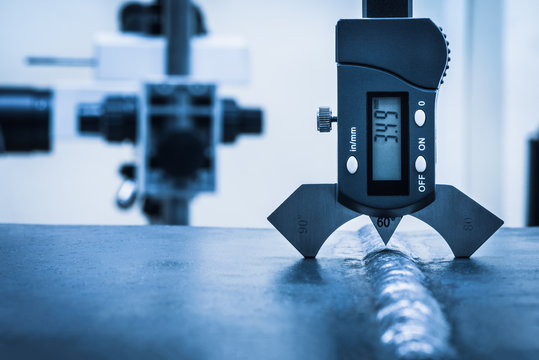The Function of Technology in Modern Welding Inspection Madison Practices
The Function of Technology in Modern Welding Inspection Madison Practices
Blog Article
The Significance of Thorough Welding Examination in Industrial Applications
In the realm of industrial applications, the relevance of thorough welding assessment can not be overemphasized. It plays a vital role in making sure the architectural stability and longevity of welded parts. Advanced non-destructive testing techniques enable for the very early detection of possible defects, such as cracks and incomplete blend, which, if left unattended, could bring about tragic failings. Furthermore, adherence to strict market criteria not only ensures high quality yet likewise constructs client self-confidence. As we check out the multifaceted benefits of diligent welding inspections, one have to think about the broader ramifications on safety, dependability, and cost-effectiveness in industrial operations.
Enhancing Architectural Honesty
When it comes to welding examination in industrial applications, enhancing structural integrity is critical. The primary goal of welding evaluation is to ensure that the welds are capable of bearing the expected lots and stresses they will run into in service.
The significance of preserving structural stability in bonded frameworks can not be overemphasized. Badly executed welds can bring about disastrous failings, leading to expensive repair services, downtime, and even endangerment of human lives. Inspectors play a critical role in the lifecycle of commercial components, offering guarantee that the welding process supplies the desired strength and longevity.
Additionally, advanced technologies, such as phased selection ultrasonic screening and electronic radiography, offer improved capabilities in finding possible weaknesses, permitting restorative steps prior to problems rise. By prioritizing the stability of welds with meticulous examination, sectors can ensure functional performance and expand the longevity of their infrastructure.
Recognizing Welding Problems
Recognizing welding flaws is a vital aspect of making sure the security and reliability of bonded frameworks. Common welding defects include porosity, fractures, insufficient fusion, and damaging.

Skilled examiners utilize both aesthetic exam and advanced non-destructive testing (NDT) approaches, such as radiographic or ultrasonic screening, to discover these problems. The prompt identification and correction of welding problems are vital to maintain the structural integrity and longevity of industrial parts.
Making Certain Compliance Requirements
Compliance with recognized requirements, such as those provided by the American Welding Society (AWS) and the International Organization for Standardization (ISO), makes certain that welds meet minimum safety and security and high quality needs. These standards incorporate a large range of standards, including product specifications, welding treatments, and credentials of welders.
Regular audits and inspections are important in view website validating compliance. Inspectors have to possess an extensive understanding of the relevant requirements and be adept at utilizing numerous non-destructive testing (NDT) techniques to examine weld top quality. By guaranteeing that welding techniques align with compliance requirements, business mitigate the threat of non-conformity, which can cause legal obligations and safety and security hazards.
In addition, preserving compliance not just safeguards structural stability but also improves a business's credibility in the market. Stakeholders and customers are most likely to trust firms that consistently show a dedication to high quality and safety via extensive compliance. Therefore, ensuring compliance requirements is an important element in the effective implementation of welding in commercial applications.
Reducing Maintenance Prices

The application of sophisticated non-destructive testing (NDT) methods, including ultrasonic, radiographic, and magnetic particle examinations, boosts the ability to spot subsurface problems without endangering the structural integrity of elements. By utilizing these strategies, markets can substantially expand the service life of their equipment, lowering downtime and the connected economic concern of upkeep tasks.
Additionally, a robust welding examination program supports the optimization of maintenance timetables, shifting from reactive to predictive upkeep methods. This aggressive technique not only curtails unanticipated failings however likewise simplifies source allotment, making sure that maintenance initiatives are concentrated and reliable. go Eventually, the financial investment in strenuous welding assessment is offset by the substantial savings realized through lowered upkeep demands, adding positively to the general functional efficiency of industrial business.
Improving Safety Measures
Welding evaluation plays an important function in this context, as it ensures that all connections and joints satisfy rigorous safety standards. Comprehensive assessments aid determine issues such as fractures, porosity, or insufficient combination that could jeopardize architectural stability.
Approaches like ultrasonic testing, radiographic testing, and magnetic particle examination permit for detailed examination without damaging the framework. Implementing a robust top quality control system that consists of regular training for welders and assessors makes certain adherence to established safety and security standards.
Lastly, cultivating a society of safety within the company highlights the significance of comprehensive welding assessments. Motivating open interaction and partnership among assessors, welders, and engineers adds to a common commitment to safety and security quality. Welding Inspection Madison. In doing so, sectors can secure their procedures, protect employees, and maintain public trust fund

Final Thought
Extensive welding inspection is essential in commercial applications, substantially improving architectural stability and integrity. By using advanced non-destructive screening approaches, potential welding flaws such as fractures and insufficient combination are identified early, making sure compliance with sector requirements and fostering customer trust fund. Strenuous assessments cause decreased upkeep costs and contribute to a safer working environment. Eventually, the persistent implementation of welding examinations plays a critical function in preserving operational effectiveness and security in industrial settings.
As we check out the multifaceted advantages of attentive welding examinations, one need to consider the wider implications on safety and security, reliability, and cost-effectiveness in commercial operations.
The primary goal of welding evaluation is to ensure that the welds are capable of bearing the anticipated tons and anxieties they will certainly run into in service. Effective welding assessment plays an important function in reducing these prices by making certain the stability and durability of welds, consequently mitigating the danger of premature failings.Detailed welding inspection is indispensable in industrial applications, substantially enhancing architectural stability and reliability. Eventually, the attentive execution of welding assessments plays an essential role in maintaining operational effectiveness and safety in commercial settings.
Report this page